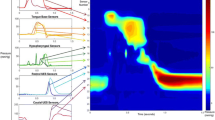Abstract
When a liquid bolus is held in the mouth, the posterior tongue and soft palate pinch together to prevent premature spillage of the bolus into the oropharynx. We propose that this glossopalatal closure acts as a glossopalatal sphincter (GPS). In this investigation, we studied glossopalatal closure by obtaining concurrent manometric and radiographic recordings of barium swallows in healthy volunteers. Manometry was done by both a continuous pullthrough method and also by a stationary catheter technique using a ribbon catheter with multiple sideholes spaced at 1-cm intervals. The results showed that when the mouth was loaded with a fluid bolus, the closed glossopalatal segment generated an asymmetric high-pressure zone with greater pressures toward the tongue and palate than laterally. With swallowing, the glossopalatal sphincter high-pressure zone relaxed and the glossopalatal sphincter opened to allow barium to flow from the mouth into the oropharynx. We conclude that the glossopalatal sphincter functions as a physiological sphincter in that it (1) generates a sustained high-pressure zone and closure when a liquid bolus is held in the mouth and (2) relaxes and opens with swallowing.
Similar content being viewed by others
References
Donner MW, Bosma JF, Robertson DL: Anatomy and physiology of the pharynx. Gastrointest Radiol 10:196–212, 1985
Rubesin SE, Jones B, Donner MW: Radiology of the adult soft palate. Dysphagia 2:8–17, 1987
Cook IJ, Dodds WJ, Dantas RO, Kern MK, Massey BT, Shaker R, Hogan WJ: Timing of videofluoroscopic, manometric events and bolus transit during the oral and pharyngeal phases of swallowing. Dysphagia 4:8–15, 1989
Arndorfer RC, Stef JJ, Dodds WJ, Linehan JH, Hogan WJ: Improved infusion system for intraluminal esophageal manometry. Gastroenterology 73:23–27, 1977
Kahrilas PJ, Dodds WJ, Dent J, Logemann JS, Shaker R: Upper esophageal sphincter function during deglutition. Gastroenterology 92:52–62, 1988
Dodds WJ, Man KM, Cook IJ, Kahrilas PJ, Stewart ET, Kern MK: Influences of bolus volume on swallow-induced hyoid movement in normal subjects. AJR 150:1307–1309, 1988
Code CF, Schlegel JF: Motor actions of the esophagus and its sphincters,In Handbook of Physiology, Code CF (ed)., section G: Alimentary Canal, vol. 4: Motility. Washington, DC, American Physiological Society, 1968, pp 1821–1839
Dodds WJ, Kahrilas PJ, Dent J, Hogan WJ: Considerations about pharyngeal manometry. Dysphagia 1:209–214, 1987
Logemann JA: Manual for the Videofluorographic Study of Swallowing. San Diego; College Hill Press, 1986
Dent J, Dodds WJ, Hogan WJ, Toouli J: Factors that influence the induction of gastroesophageal reflux in normal human subjects. Dig Dis Sci 33:270–275, 1988
Biancani P, Zabinski MP, Kerstein MD, Behar J: Mechanical characteristics of the cat pylorus. Gastroenterology 78:301–309, 1980
Saunders JB, Davis C, Miller ER: The mechanism of deglutition (second stage) as revealed by cine-radiography. Ann Otol. Rhinol Laryngol 60:897–916, 1951
McConnel FMS, Cerenko D, Hersh T, Weil LJ: Evaluation of pharyngeal dysphagia with manofluorography. Dysphagia 2:187–195, 1988
Winans CS: The pharyngoesophageal closure mechanism: A manometric study. Gastroenterology 63:768–777, 1972
Kahrilas PJ, Dent J, Dodds WJ, Hogan WJ, Arndorfer RC: A method for continuous monitoring of upper esophageal sphincter pressure. Dig Dis Sci 32:121–128, 1987
Basmajian JV, Dutta CR: Electromyography of the pharyngeal constrictors and levator palati in man. Anat Rec 139:561–563, 1961
Logemann JA: Treatment for aspiration related to dysphagia: An overview. Dysphagia 1:34–38, 1986
Author information
Authors and Affiliations
Additional information
Supported in part by USPHS grant DK25731.
Dr. Dantas was supported by a grant from the Fundaçáo de Amparo à Pesquisa do Estado de Sáo Paulo (FAPESP), Brazil.
Rights and permissions
About this article
Cite this article
Dantas, R.O., Dodds, W.J., Massey, B.T. et al. Manometric characteristics of glossopalatal sphincter. Digest Dis Sci 35, 161–166 (1990). https://doi.org/10.1007/BF01536757
Received:
Accepted:
Issue Date:
DOI: https://doi.org/10.1007/BF01536757




